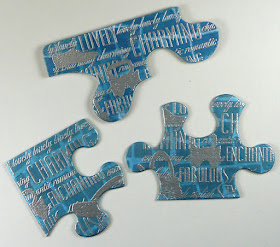One of the fun things to do at a Club Scrap retreat is participate in a swap. This year, we swapped altered puzzle pieces. Some google searching did not yield many ideas, so I struggled a bit with this. I really like to add paper to altered objects, but couldn't imagine cutting around all of the pieces. I finally decided to work with inks and embossing. To start, find a puzzle with fairly large pieces - I thought this child's puzzle would be great (I found mine at Goodwill).
Next, I sanded the pieces a bit to rub off some of the paper, and provide some "tooth" for the next step.
I then painted each piece with two coats of gesso. I like to start with a white surface when I alter items. I do the same thing when I alter board books. I used a mini-file to round off any bumps and to lightly sand the worst of my brush strokes off of the surface.
Each piece then got a coat of ink. Pigment ink worked great for this, as did brilliance ink. I'm showing one of my pigment ink samples here. I let these dry overnight. You could use a heat gun, but it takes a while with 20+ pieces.
To add a bit of texture (and fit with the Club Scrap retreat), I used a stencil from a kit and a mist to spray. Interestingly, I got super sharp transfer when I tried this out the day before, but some of these bled and really faded a lot. I'm wondering if my pigment ink was "wetter" when I did it the day before.
Since some of them were too light or monotone for me, I used some different inks with the stencil to apply another dimension to the background.
Finally, I embossed a background stamp on the puzzle piece with Stampin' Up! silver embossing powder. By far, they make the best embossing powders in my opinion. I also did a quick coat with acrylic sealer to give the overall surface a little shine (this is before the coat).
Some tips for altered projects:
- Make a lot. I always start with more than I need so I can experiment and try some things out. This puzzle also had some damaged pieces, so those made great test pieces.
- Test your techniques. I used a piece of chipboard and gesso coated it to see what inks would dry on the surface. It turned out that all of them did (eventually) so that made the options pretty open.
- Set aside lots of time. I messed up with this one this time around! The pigment ink dried nicely overnight, and the mist would have dried nicely overnight if I had the time. Your heat gun can speed things up, but at a few minutes for each piece, this was a lot of time I could have used for other activities.
- Dye ink and gloss medium do not mix. Some of my stenciling was with dye ink, and I tried to put some glossy medium on top. I loved the way this look, but it caused all of my dye ink to bleed. (This is why I make a lot!)
- Be flexible. My misting worked one day, but not the next. My pigment ink pad went a little dry. I improvised by using other ink pads, and adding some stenciling. It's altered, so it's all good. It makes each piece unique!
- Have fun! I stressed when I couldn't find a lot of examples to guide me, but it is fun to experiment and try something a bit different.
I'll post the items I swapped for later and a few more pictures of my favorite pieces I made. By the time you read this, I will have done the swap, and can't wait to be inspired by their creativity!















































